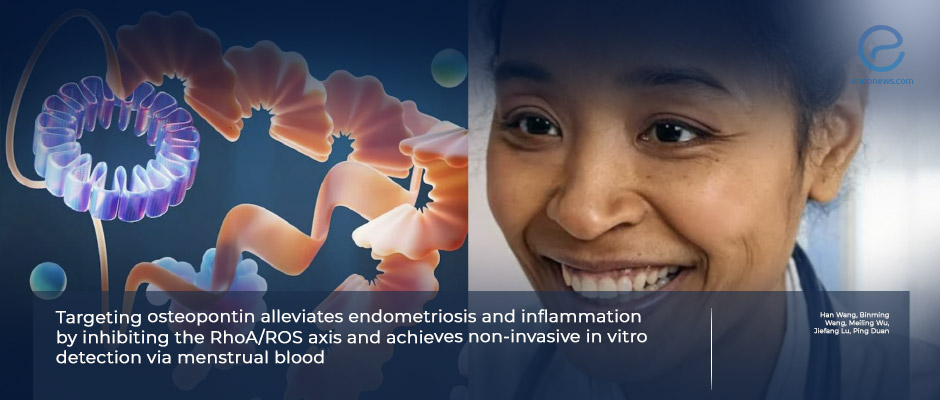Targeting Osteopontin to Detect and Treat Endometriosis
May 15, 2025
Osteopontin drives necroptosis and inflammation in endometriosis; its inhibition may suppress lesion growth.
Key Points
Highlights:
- Osteopontin is significantly upregulated in endometriosis stromal cells and menstrual blood of patients with endometriosis.
- Targeting osteopontin reduces necroptosis, the release of pro-inflammatory cytokines, and suppresses lesion growth in a mouse model.
Importance:
- Targeting osteopontin may offer a dual benefit in endimetriosis:
- Enabling early detection-diagnosis, via menstrual blood analysis, and
- Treatment by reducing inflammation, via anti-inflammatory and anti-necroptotic effects.
What’s done here:
- Researchers analyzed ectopic, eutopic, and menstrual blood stromal cells from 20 patients with endometriosis and 10 healthy controls.
- Osteopontin expression levels and its effect on inflammatory cytokines were assesed.
- Necroptosis pathways, including mitochondrial stress were investigated to verify the regulation of necroptosis and inflammatory factor levels.
- Osteopontin knockdown experiments were conducted to evaluate its impact on lesion growth and inflammation in vivo.
Key results:
- Osteopontin inhibition reduced MLKL phosphorylation, RhoA-mediatedeactive oxygen species, and pro-inflammatory cytokines such as IL-1β, TNF-α.
- Mouse studies confirmed suppressed lesion volume and attenuated inflammation.
- Menstrual blood-derived stromal cells expressed osteopontin, suggesting potential for non-invasive detection.
Limitations:
- Tissue samples were collected during proliferative and secretory phases; expression during other days of the phase is unknown.
- The small sample size limits generalizability and warrants further validation.
From the Editor-in-Chief – EndoNews
"Targeting osteopontin may represent a significant step toward non-hormonal, mechanism-based therapies in endometriosis—offering hope for improved diagnosis and symptom control across diverse disease stages and symptom profiles, without compromising reproductive or emotional health."
Lay Summary
The protein osteopontin is significantly elevated in ectopic endometrial stromal cells and in the menstrual blood of individuals with endometriosis, according to a recent study published in Human Reproduction.
The findings suggest that osteopontin plays a key role in driving inflammation and lesion development in endometriosis—and may serve as both a therapeutic target and a non-invasive diagnostic marker.
To explore this, a research team led by Dr. Ping Duan from the Department of Obstetrics and Gynecology at The Second Affiliated Hospital and Yuying Children's Hospital of Wenzhou Medical University in China analyzed tissue and menstrual blood samples from 20 women with endometriosis and 10 healthy controls.
The investigators found that osteopontin expression was significantly upregulated in endometriotic lesions and menstrual blood-derived stromal cells. When they knocked down osteopontin in vitro, they observed a marked reduction in necroptosis—a pro-inflammatory form of regulated cell death—as well as a decrease in the release of inflammatory cytokines.
Mechanistically, the inhibition of necroptosis occurred through suppression of RhoA-mediated reactive oxygen species production and phosphorylation of MLKL, a key necroptosis effector protein.
Importantly, targeting osteopontin in vivo in a mouse model led to reduced lesion growth and inflammation, suggesting potential therapeutic benefit.
“Our findings highlight the pivotal role of the osteopontin–RhoA–ROS axis in regulating necroptosis and inflammatory signaling in endometriosis,” the authors concluded. They suggest that targeting osteopontin may open new avenues for both early detection and treatment of the disease.
Research Source: https://pubmed.ncbi.nlm.nih.gov/38511216/
osteopontin non-invasive diagnosis inflammation therapeutic target

